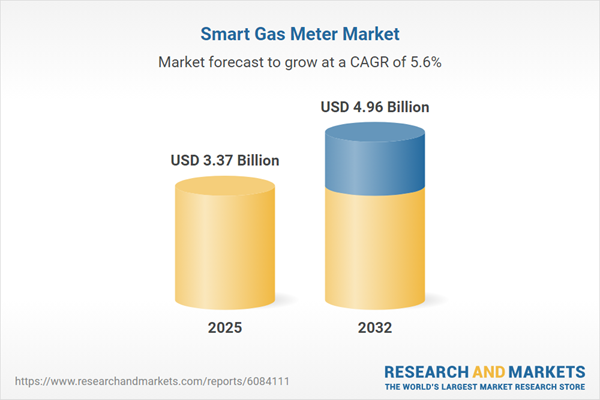Speak directly to the analyst to clarify any post sales queries you may have.
The smart gas meter market is at a pivotal moment, driven by utility priorities for operational efficiency, regulatory alignment, and enhanced consumer interaction. As digitalization transforms utility infrastructure, decision-makers require reliable insights into market trajectories and actionable strategies to future-proof investments in gas metering.
Market Snapshot: Smart Gas Meter Market Size and Growth Trends
The global smart gas meter market is experiencing notable momentum, registering strong growth from 2024 through 2032. The market is advancing at a compound annual growth rate that reflects utilities’ rising need for precise consumption data, optimized network operations, and streamlined compliance with evolving regulations. Stakeholders are responding to heightened expectations for sustainability, safety, and digitized customer experiences as connected gas metering becomes an essential utility upgrade.
Scope & Segmentation
This report offers detailed insights across technologies, end uses, and geographical regions. Clear segmentation helps leaders align strategic planning with sector priorities.
- Meter Types: Smart diaphragm gas meters and smart ultrasonic gas meters
- Technology Types: Advanced metering infrastructure (AMI), automated meter reading (AMR)
- Installation Types: New installations, retrofit programs
- Communication Modes: Wired communication, wireless communication
- Applications: Billing, consumption monitoring, leakage detection
- End Users: Commercial, industrial, residential sectors
- Regional Focus: Americas (including United States, Canada, Mexico, Brazil, Argentina, Chile, Colombia, Peru), Europe, Middle East & Africa (with specific coverage of United Kingdom, Germany, France, Russia, Italy, Spain, Netherlands, Sweden, Poland, Switzerland, United Arab Emirates, Saudi Arabia, Qatar, Turkey, Israel, South Africa, Nigeria, Egypt, Kenya), and Asia-Pacific (countries such as China, India, Japan, Australia, South Korea, Indonesia, Thailand, Malaysia, Singapore, Taiwan)
- Company Profiles: Coverage includes Honeywell International, Inc., Itron Inc., Landis+Gyr AG by Toshiba Corporation, Hubbell Incorporated, Osaki Electric Co., Ltd., Diehl Stiftung & Co. KG, and other leading industry participants
Key Takeaways for Decision-Makers
- Utilities are transforming their distribution networks by adopting Internet of Things connectivity, edge computing, and secure communication protocols, enabling precise usage monitoring and proactive operational management.
- Segment differentiation between diaphragm and ultrasonic technologies influences utility choices, with each offering distinct advantages in accuracy, maintenance, and retrofit potential.
- Deployment decisions are shaped by the condition of existing assets and regulatory requirements, with retrofits extending legacy value and new installations providing streamlined integration of advanced features.
- Wireless communication is gaining traction for scalable, flexible rollouts, especially where reliable installation or maintenance access is critical across urban and remote contexts.
- Aftermarket services including predictive maintenance, firmware updates, and customer-facing portals are establishing new benchmarks for lifecycle support and deepening utility-vendor partnerships.
Tariff Impact: Navigating Trade Policy Changes
Recent changes in United States tariffs are reshaping global supply chains by increasing costs for key components such as ultrasonic transducers and communication modules. This is prompting manufacturers to diversify sourcing and consider alternative production locations. Utilities must integrate tariff uncertainty into procurement plans, utilizing scenario analysis and collaborative agreements to safeguard modernization projects from pricing or lead time fluctuations.
Methodology & Data Sources
Our research integrates in-depth primary interviews with utility leaders, technology developers, and regulatory authorities. This is reinforced with secondary data from industry reports, patent literature, and regulatory filings, which are validated through advanced analytical frameworks and scenario modeling to ensure robust, real-world conclusions.
Why This Report Matters to Senior Decision-Makers
- Identify actionable strategies to align technology investments with fast-evolving compliance and sustainability requirements in the smart gas meter market.
- Benchmark competitor approaches, innovation roadmaps, and service offerings to inform balanced build-or-buy decisions.
- Accelerate ROI through targeted guidance on segmentation, risk management, and regional deployment priorities.
Conclusion
Industry transformation in gas metering demands a strategic approach to technology, partnerships, and supply resilience. This report supplies critical clarity for utility and supplier leadership to drive innovation, streamline operations, and secure sustainable growth.
Table of Contents
3. Executive Summary
4. Market Overview
7. Cumulative Impact of Artificial Intelligence 2025
List of Figures
Samples

LOADING...
Companies Mentioned
The key companies profiled in this Smart Gas Meter market report include:- Hubbell Incorporated
- Adya Smart Metering Pvt Ltd.
- Aichi Tokei Denki Co., Ltd.
- Apator Group
- Chongqing Shancheng Gas Equipment Co., Ltd.
- Diehl Stiftung & Co. KG
- Discovergy GmbH
- Osaki Electric Co., Ltd.
- Fujitsu Limited
- Honeywell International, Inc.
- Itron Inc.
- Landis+Gyr AG by Toshiba Corporation
- Pietro Fiorentini S.p.a.
- CHINT Group Corporation
- Genus Power Infrastructures Ltd.
- Silicon Laboratories, Inc
- Sopan
- Semtech Corporation
- Cavagna Group
- Tata Communications Limited
- Kimpex Flow Pvt. Ltd.
- Xylem Inc.
- Cubic Sensor and Instrument Co., Ltd.
Table Information
| Report Attribute | Details |
|---|---|
| No. of Pages | 194 |
| Published | October 2025 |
| Forecast Period | 2025 - 2032 |
| Estimated Market Value ( USD | $ 3.37 Billion |
| Forecasted Market Value ( USD | $ 4.96 Billion |
| Compound Annual Growth Rate | 5.6% |
| Regions Covered | Global |
| No. of Companies Mentioned | 24 |









